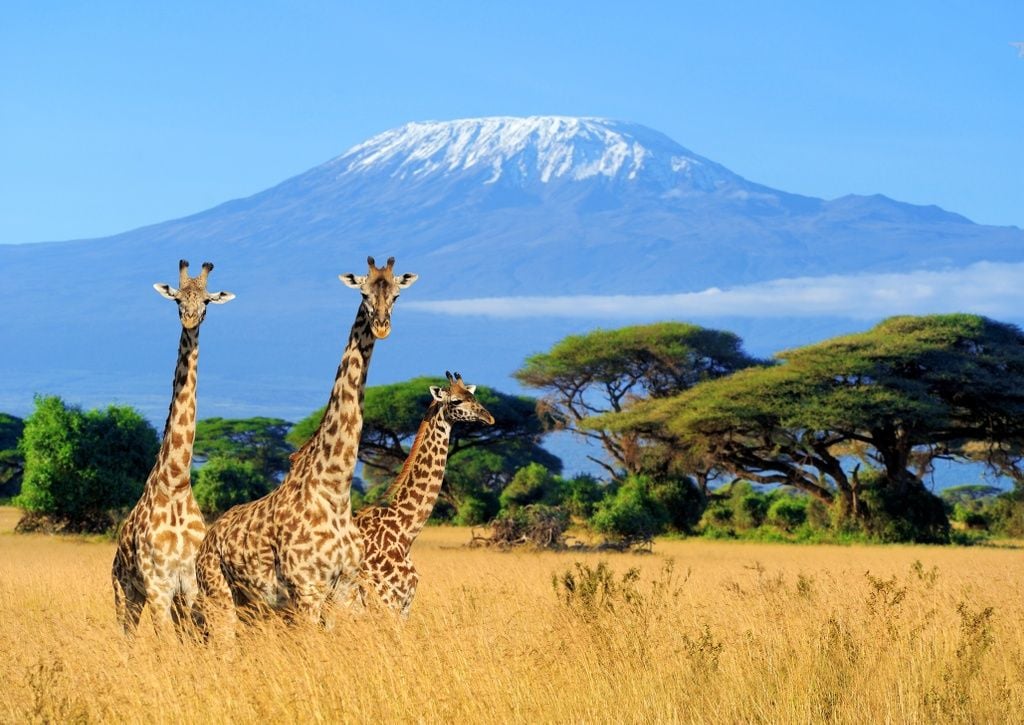KILIMANJARO MOUNTAIN

ABOUT KILIMANJARO MOUNTAIN
Mount Kilimanjaro is the world's highest free-standing mountain. It is known as the “Roof of Africa” (Standing at 5,895 meters). Embark on a seven-day journey that unveils breathtaking glacial landscapes, mesmerizing sunrises, and the charm of rare flora amidst tropical forests. Feel the thrill of exploration as you traverse this unique hiking adventure. No technical climbing skills are needed. With a moderate level of fitness and the help of our expert guides, you'll conquer this iconic mountain.
Kilimanjaro Trekking
There are many reasons why you might be drawn to trek Kilimanjaro and the more you know about the mountain you are about to tackle
(or are dreaming of tackling) the more enjoyable your experience will be. Not to mention being able to impress your friends about how much you know!
We’ve got some lesser-known facts to share about this mountain – from its geology and history to modern-day records and achievements.
Mt Kilimanjaro Facts
Mount Kilimanjaro is the world's tallest free-standing mountain
Kilimanjaro is the highest free-standing mountain – that is, not part of a mountain range, such as the Himalayas – in the world, at 5,895 meters above sea level. It actually comprises three volcanic peaks, the largest being Kibo – the summit. The other two cones are Mawenzi and Shira.
Mount Kilimanjaro is one of the world's Seven Summits
The Seven Summits is the name given to the highest peaks from each continent. They vary greatly in height, topography and climbing difficulty. For some ambitious folks, it's a goal to hike all Seven Summits. Others aim to also visit the North and South Poles and so complete what's known as the Adventurer's Grand Slam.
Everest is the most famous of the Seven Summits, of course, with Kilimanjaro probably the next most commonly known. Mount Kilimanjaro, as you can see, is the fourth highest of the Seven Summits.
Climate Zones on Kilimanjaro
It has been suggested that walking from the bottom of the mountain to the top is like walking from the equator to the North Pole – in terms of the climate
zones you pass through.
There are five major zones on Mount Kilimanjaro :
Cultivation Zone (2,500 feet – 5,900 feet)
The lower slopes of the mountain would once have been rolling savanna grassland but are now mostly cultivated by small scale farmers, and used as grazing land for livestock.
Montane Rain forest (5,900 feet – 9,200 feet)
The humid rain forest receives the most rainfall and was once home to a variety of wildlife. Due to the increase in tourism, you’d be hard-pressed to see anything other than the odd antelope and some monkeys. But the bird life is spectacular!
Low Alpine Heath and Moorland Zone (9,200 feet – 13,000 feet)
The temperatures are cooler here and it is much drier than in the forest. The vegetation is a mixture of heather’s and large grasses. Giant senecios and lobelias are in abundance as you get higher in this zone.
Alpine Desert (13,000 feet – 16,400 feet)
As you climb higher, out of the heath and moorland zone it gets a lot bleaker. Much colder at night, and baking hot during the day, it is an inhospitable place. There isn’t much precipitation here and as a result, the landscape is rocky with little soil to support vegetation.
Ice Cap Zone, the Arctic Tundra (16,400 feet – 19,340 feet)
This area comprises mostly rocks and volcanic scree with glaciers higher up. There is very little water, as most precipitation falls as snow and is absorbed by porous rock. It is bleak and very cold. But it is spectacular!
A beautiful flower in Kilimanjaro's forest grows nowhere else
Kilimanjaro in History
Many classical geographers were interested in the African continent, and the first recorded mention of Kili in history was in the second century. The Greek mathematician, Ptolemy of Alexandria referred to “a great snow mountain”. Later on, Oriental traders reported news of a “great mountain west of Zanzibar”.
In his “Suma de Geographia”, Fernandez de Encisco, a Spanish writer mentions “an Ethiopian Mount Olympus’; after traveling to the Kenyan port of Mombasa and apparently speaking to people who had visited the interior.
In typical style, early nineteenth-century British geographers had dismissed any idea of a snow-capped peak in Africa. That is, until William Desborough Cooley in 1844 wrote: “the most famous mountain of Eastern Africa is Kirimanjara”. This is thought to be the first mention of any form of the modern name Kilimanjaro.
Still stubborn, the Royal Geographic Society dismissed the claim of the German missionary, Johannes Rebmann, who actually traveled to the ‘interior’ and seen Kili for himself in 1848.
Just goes to show how wrong these naysayers were!








